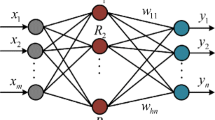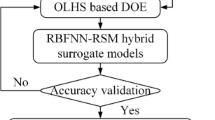Abstract
Cross-section optimization is an effective way to improve the mechanical performance of a vehicle body and reduce its structural mass. However, previous studies suffer from the deficiencies involving inaccurate cross-sectional model, insufficient consideration of manufacturability constraints and inefficient single-objective optimization. In this work, eight typical cross-sections of a body are optimized. A chain node-based parametric modeling is proposed to realize accurately cross-sectional discretization, and the geometric and manufacturability constraints as well as three optimization objectives are considered in the cross-sectional optimization models. To realize multi-objective optimization, a multi-objective intelligence adaptive optimization algorithm (MIAOA) is proposed. By classifying the non-dominated solutions and applying a reward-penalty strategy, the MIAOA realizes intelligent iteration. The experimental results on ZDT and DTLZ suites obtained by MIAOA are better than those of five typical algorithms in terms of convergence, stability, uniformity and extensiveness. Besides, the MIAOA is applied to improve the moments of inertia of the cross-sections and reduce their material areas. These optimized cross-sections are applied to the body, and the optimized body shows better mechanical performances involving torsional stiffness, bending stiffness, first-order mode and second-order mode, while reducing the total mass by 9.96 kg. In conclusion, the proposed methods can effectively realize lightweight automobiles.





















Similar content being viewed by others
References
Akhavan Attar A, Kazemi M (2022) Novel geometric arrangement effects on energy absorption of a conical structure with various cross-sections. Thin Wall Struct 173:109005. https://doi.org/10.1016/j.tws.2022.109005
Bai J, Zuo W (2020) Hollow structural design in topology optimization via moving morphable component method. Struct Multidisc Optim 61(1):187–205. https://doi.org/10.1007/s00158-019-02353-0
Bai J, Li Y, Zuo W (2017) Cross-sectional shape optimisation for thin-walled beam crashworthiness with stamping constraints using genetic algorithm. Int J Veh Des 73(1/2/3):76. https://doi.org/10.1504/ijvd.2017.082582
Bendsøe MP, Kikuchi N (1988) Generating optimal topologies in structural design using a homogenization method. Comput Methods Appl Mech Eng 71(2):197–224. https://doi.org/10.1016/0045-7825(88)90086-2
Bourdin B, Chambolle A (2003) Design-dependent loads in topology optimization. ESAIM Contr Optim Ca 9:19–48. https://doi.org/10.1051/cocv:2002070
Chen W, Zuo W (2014) Component sensitivity analysis of conceptual vehicle body for lightweight design under static and dynamic stiffness demands. Int J Veh Des 66(2):107–123. https://doi.org/10.1504/ijvd.2014.064546
Coniglio S, Morlier J, Gogu C, Amargier R (2020) Generalized geometry projection: a unified approach for geometric feature based topology optimization. Arch Comput Method E 27(5):1573–1610. https://doi.org/10.1007/s11831-019-09362-8
Donders S, Takahashi Y, Hadjit R, Van Langenhove T, Brughmans M, Van Genechten B, Desmet W (2009) A reduced beam and joint concept modeling approach to optimize global vehicle body dynamics. Finite Elem Anal Des 45(6):439–455. https://doi.org/10.1016/j.finel.2008.12.004
Duan L, Xiao N-C, Hu Z, Li G, Cheng A (2016) An efficient lightweight design strategy for body-in-white based on implicit parameterization technique. Struct Multidisc Optim 55(5):1927–1943. https://doi.org/10.1007/s00158-016-1621-0
Faramarzi A, Heidarinejad M, Mirjalili S, Gandomi AH (2020) Marine predators algorithm: a nature-inspired metaheuristic. Expert Syst Appl 152:113377. https://doi.org/10.1016/j.eswa.2020.113377
Guo G, Zhao Y, Su W, Zuo W (2021) Topology optimization of thin-walled cross section using moving morphable components approach. Struct Multidisc Optim 63(5):2159–2176. https://doi.org/10.1007/s00158-020-02792-0
Jangir P, Buch H, Mirjalili S, Manoharan P (2021) MOMPA: multi-objective marine predator algorithm for solving multi-objective optimization problems. Evolut Intell. https://doi.org/10.1007/s12065-021-00649-z
Koganti R, Weishaar J (2009) Aluminum vehicle body construction and enabling manufacturing technologies. SAE Int J Mater Manuf 1(1):491–502. https://doi.org/10.4271/2008-01-1089
Li S, Feng X (2020) Study of structural optimization design on a certain vehicle body-in-white based on stimpatic performance and modal analysis. Mech Syst Signal Process 135:106405. https://doi.org/10.1016/j.ymssp.2019.106405
Liu J, Dai Q (2020) Portfolio optimization of photovoltaic/battery energy storage/electric vehicle charging stations with sustainability perspective based on cumulative prospect theory and MOPSO. Sustainability 12(3):985. https://doi.org/10.3390/su12030985
Lu S, Ma H, Xin L, Zuo W (2019) Lightweight design of bus frames from multi-material topology optimization to cross-sectional size optimization. Eng Optim 51(6):961–977. https://doi.org/10.1080/0305215x.2018.1506770
Ma Y, Chen R, Bai J, Zuo W (2020) Shape optimization of thin-walled cross section for automobile body considering stamping cost, manufacturability and structural stiffness. Int J Automot Technol 21(2):503–512. https://doi.org/10.1007/s12239-020-0047-2
Mantegna RN (1994) Fast, accurate algorithm for numerical simulation of L’evy stable stochastic processes. Phys Rev E 49(5):4677–4683. https://doi.org/10.1103/physreve.49.4677
Mirjalili S, Saremi S, Mirjalili SM, Coelho LS (2016) Multi-objective grey wolf optimizer: a novel algorithm for multi-criterion optimization. Expert Syst Appl 47:106–119. https://doi.org/10.1016/j.eswa.2015.10.039
Mlejnek HP (1992) Some aspects of the genesis of structures. Struct Multidisc Optim 5(1):64–69. https://doi.org/10.1007/bf01744697
Nia A, Parsapour M (2014) Comparative analysis of energy absorption capacity of simple and multi-cell thin-walled tubes with triangular, square, hexagonal and octagonal sections. Thin Wall Struct 74:155–165. https://doi.org/10.1016/j.tws.2013.10.005
Schramm U, Pilkey WD (1993) Structural shape optimization for the torsion problem using direct integration and B-splines. Comput Method Appl Mech Eng 107(1):251–268. https://doi.org/10.1016/0045-7825(93)90179-2
Sethian JA (1999) Level set methods and fast marching methods: evolving interfaces in computational geometry, fluid mechanics, computer vision, and materials science, 2nd edn. Cambridge University Press, Cambridge
Shimoda M, Nagano T, Shi J-X (2019) Non-parametric shape optimization method for robust design of solid, shell, and frame structures considering loading uncertainty. Struct Multidisc Optim 59(5):1543–1565. https://doi.org/10.1007/s00158-018-2144-7
Shimoda M, Liu Y, Ishikawa K (2020) Optimum shape design of thin-walled cross sections using a parameter-free optimization method. Thin Wall Struct 148:106603. https://doi.org/10.1016/j.tws.2020.106603
Sigmund O, Maute K (2013) Topology optimization approaches: a comparative review. Struct Multidisc Optim 48(6):1031–1055. https://doi.org/10.1007/s00158-013-0978-6
Singh, Osuagwu K (1998) Body structure joint optimization: a cost driven approach. In: International body engineering conference & exposition. SAE International, Detroit. https://doi.org/10.4271/982280
Sokolowski J, Zochowski A (1999) On the topological derivative in shape optimization. SIAM J Control Optim 37(4):1251–1272. https://doi.org/10.1007/978-0-387-74759-0_682
Tanlak N (2016) Cross-sectional shape optimization of thin-walled columns enduring oblique impact loads. Thin Wall Struct 109:65–72. https://doi.org/10.1016/j.tws.2016.09.009
Topping J (1956) Investigations on the theory of the Brownian movement. Phys Bull 7(10):281–281. https://doi.org/10.1088/0031-9112/7/10/012
Tsai C-Y, Yeh S-W (2008) A multiple objective particle swarm optimization approach for inventory classification. Int J Prod Econ 114(2):656–666. https://doi.org/10.1016/j.ijpe.2008.02.017
Tunç B, Şendur P (2019) A new methodology to determine the design sensitivity of critical automotive body joints for basic design cycle. Proc Inst Mech Eng D 233(10):2559–2571. https://doi.org/10.1177/0954407018800584
Verma S, Pant M, Snasel V (2021) A comprehensive review on NSGA-II for multi-objective combinatorial optimization problems. IEEE Access 9:57757–57791. https://doi.org/10.1109/ACCESS.2021.3070634
Vinot P, Cogan S, Piranda J (2001) Shape optimization of thin-walled beam-like structures. Thin Wall Struct 39(7):611–630. https://doi.org/10.1016/s0263-8231(01)00024-6
Wang D, Zhang S, Wang C, Zhang C (2018) Structure-material-performance integration lightweight optimisation design for frontal bumper system. Int J Crashworth 23(3):311–327. https://doi.org/10.1080/13588265.2017.1317468
Xie YM, Steven GP (1993) A simple evolutionary procedure for structural optimization. Comput Struct 49(5):885–896. https://doi.org/10.1016/0045-7949(93)90035-c
Zhang C, Tan KC, Lee LH, Gao L (2017) Adjust weight vectors in MOEA/D for bi-objective optimization problems with discontinuous Pareto fronts. Soft Comput 22(12):3997–4012. https://doi.org/10.1007/s00500-017-2609-4
Zhang W, Jiang S, Liu C, Li D, Kang P, Youn S-K, Guo X (2020a) Stress-related topology optimization of shell structures using IGA/TSA-based moving morphable void (MMV) approach. Comput Method Appl Mech Eng 366:113036. https://doi.org/10.1016/j.cma.2020a.113036
Zhang W, Li D, Kang P, Guo X, Youn S-K (2020b) Explicit topology optimization using IGA-based moving morphable void (MMV) approach. Comput Method Appl Mech Eng 360:112685. https://doi.org/10.1016/j.cma.2019.112685
Zhong K, Zhou G, Deng W, Zhou Y, Luo Q (2021) MOMPA: multi-objective marine predator algorithm. Comput Method Appl Mech Eng 385:114029. https://doi.org/10.1016/j.cma.2021.114029
Zuo W, Lu Y, Zhao X, Bai J (2018) Cross-sectional shape design of automobile structure considering rigidity and driver’s field of view. Adv Eng Softw 115:161–167. https://doi.org/10.1016/j.advengsoft.2017.09.006
Acknowledgements
The work is supported from National Key R&D Program of China (Grant No. 2020YFA0710904-03 and Grant No. 2019YFB1706504), National Natural Science Foundation of China (Grant No. U20A20285 and Grant No. 52005054), Natural Science Foundation of Hunan Province (Grant No. 2021JJ40585), Distinguished Young Scholar Foundation of Hunan Province (Grant No. 2021JJ10016).
Author information
Authors and Affiliations
Contributions
CZ: conceptualization, methodology, writing-original draft. ZH: data curation, formal analysis. QL: writing-review & editing. YC: visualization, validation, software. YC: investigation, resources, supervision. SC: validation, software.
Corresponding author
Ethics declarations
Conflict of interest
The authors declare that they have no known competing financial interests or personal relationships that could have appeared to influence the work reported in this work.
Replication of results
The mathematical expression of proposed CNPOM is presented as Eq. (17). The details of test functions, experiment results and boundary conditions are illustrated in Supplementary File. The full codes of MIAOA, datasets of cross-sections and FEA models of vehicle body in this study are available from the authors upon reasonable request.
Additional information
Responsible Editor: Erdem Acar
Publisher's Note
Springer Nature remains neutral with regard to jurisdictional claims in published maps and institutional affiliations.
Supplementary Information
Below is the link to the electronic supplementary material.
Rights and permissions
Springer Nature or its licensor (e.g. a society or other partner) holds exclusive rights to this article under a publishing agreement with the author(s) or other rightsholder(s); author self-archiving of the accepted manuscript version of this article is solely governed by the terms of such publishing agreement and applicable law.
About this article
Cite this article
Zhang, C., He, Z., Li, Q. et al. Cross-section optimization of vehicle body through multi-objective intelligence adaptive optimization algorithm. Struct Multidisc Optim 66, 38 (2023). https://doi.org/10.1007/s00158-023-03499-8
Received:
Revised:
Accepted:
Published:
DOI: https://doi.org/10.1007/s00158-023-03499-8




